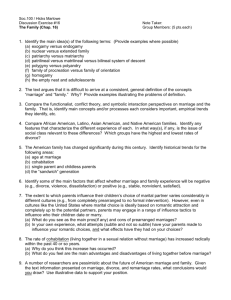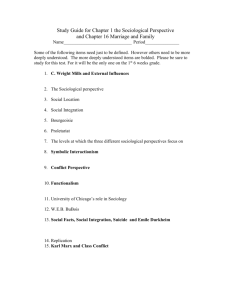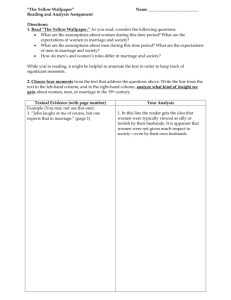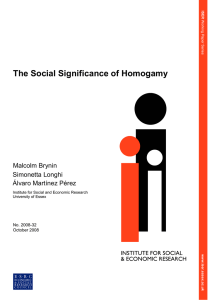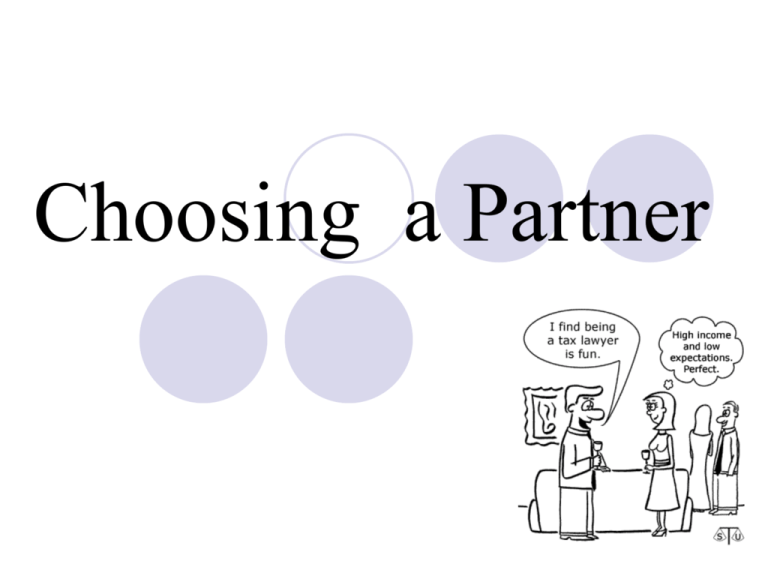
Choosing a Partner
Selecting a Spouse: Two Models
The Function of Arranged Marriage
(Ahmed)
1. Where does power reside?
2. Reaffirming which system?
3. Strategic in consolidating what?
4. Arranged marriage & Collectivist Culture
5. Too big of a decision for two youth!
Courtly Love
Model of factors affecting
Marital Stability (p. 208)
Beliefs & attitudes
About Part. or Relationship
Personality
Traits
Partner
interaction
Social
Support
Satisfaction
Stability
Exchange Theory
The process of looking for a mate
1. Hence, “the marriage market!”
2. What do you bring to the table?
3. What can you do for me?!
Permanent Availability Model
of Marriage (Faber)
All adults are in effect,
permanently available to marry,
even if already married
Traditional Marriage Exchange
RELATED TO:
1. Traditional Gender Roles
2. Morality of Sexual Restraint
Traditional Marriage Exchange
Women
* Sexual Favors
* Attractiveness
* Ability to bear Children
Traditional Marriage Exchange
Men
* Protection
* Status
* Economic Support
Marriage Exchange in a Changing
Society
Optimistic: as women gain occupational &
economic equality with men, the basis for
exchange will also become more equal, with
both partners valuing the same set of
resources:
*
*
*
What’s the downside of today’s model, i.e., pessimistic view?
Principles of HOMOGAMY
Endogamy :marrying within one’s social group
(opposite-exogamy)
Heterogamy, marrying someone of different
race, EDU. age, religion or class)
1.
2.
3.
4.
5.
Different Dimensions of Homogamy
(Whyte)
Three different Marriage Cohorts:
1. Married between 1925-44
2. Married between 1945-64
3. Married between 1965-84
Different Dimensions of Homogamy
(Whyte)
RACE: Significant across all groups
ETHNICITY: some influence in groups #1 & #2;
decreasing influence in group #3
RELIGION: some influence in group #1 & #2;
decreasing influence in group #3
Different Dimensions of Homogamy
(Whyte)
SOCIAL CLASS: Important across all groups, however,
how it’s measured changed from family origin
characteristics (father’s occupation & money earned)
to personal characteristics (education, own job and
money earned)
PARENTAL INFLUENCE: not a factor in any group.
Parental pressure toward homogamous marriage
actually produced opposite effect.
Theories of Mate Selection
Individualistic Theories
Sociological Theories
Parent Image Theory (Freud)
The Oedipus Complex: we seek a partner
who is like our mother (for boys) or our
father (for girls).
Attachment Theory (p189)
During infancy and childhood, we
learn a system or style of attaching to
others:
1.
2.
3.
Theory of Complimentary Needs
(Winch)
After “filtering” for similar others (homogamy),
we then look for important differences
Three complimentary needs:
1.
2.
3.
Stages of Intimacy
(Backman & Secord)
1.
2.
3.
4.
Murstein’s “Filtering Theory”
Stimulus-Values-Roles (SVR)
S: Initial physical attraction
V: Partners compare values to see if there is an
“appropriate” match.
R: Prospective spouses test and negotiate how
they will play their respective marital and
leisure roles
Courtship: Three Styles
1.
2.
3.
Dating as Courtship Mead’s Criticism
A competitive game in which Americans, preoccupied
with success, try to be the most popular and have the
most dates.
Two major problems with dating:
1.
2.
Solution: Two-Stage Marriage
Getting together
Characterized as large groups coming together
for a party or shared activity.
1. How does meeting in groups differ from going
on a date?
2. How does going out with the girls differ from
going on a date?
3. How have attitudes toward marriage change?
4. Why might going out in groups help you pick a
better spouse?
Cohabitation
Selection Hypothesis:
Assumes that people that choose serial
cohabitation are different from those
who do not.
a. Less effective in problem-solving
and communication skills
b. more negative attitudes toward
marriage
Cohabitation
Experience Hypothesis:
Posits that cohabiting experiences
themselves affect individual so that,
once married, they are more likely to
divorce
a.
b.
Courtship Violence:
Where do you Learn to be Violent?
Courtship Violence
20% in Cohabiting
20-40% in Dating relationships
Date Rape
50% of Freshman and Sophomore Women
report unwanted attempts at intercourse
(83% “Men they knew moderately well”)
50% of these attempts succeeded
Non of the women reported the rape
1 in 15 college men admit to behavior classified
as rape
Rape Myths
Stranger Rape/ Rapists are mentally ill
Almost 2/3 of rapes were committed by someone known to
the victim (RAINN, 2008): www.rainn.org
73% of sexual assaults were perpetrated by a non-stranger
38% of rapists are a friend or acquaintance.
28% are an intimate
7% are a relative
93% of juvenile sexual assault victims know their attacker
(RAINN, 2008): www.rainn.org
34.2% of attackers were family members
58.7% were acquaintances
Only 7% of the perpetrators were strangers to the victim
Men cannot Control themselves
Provoked




